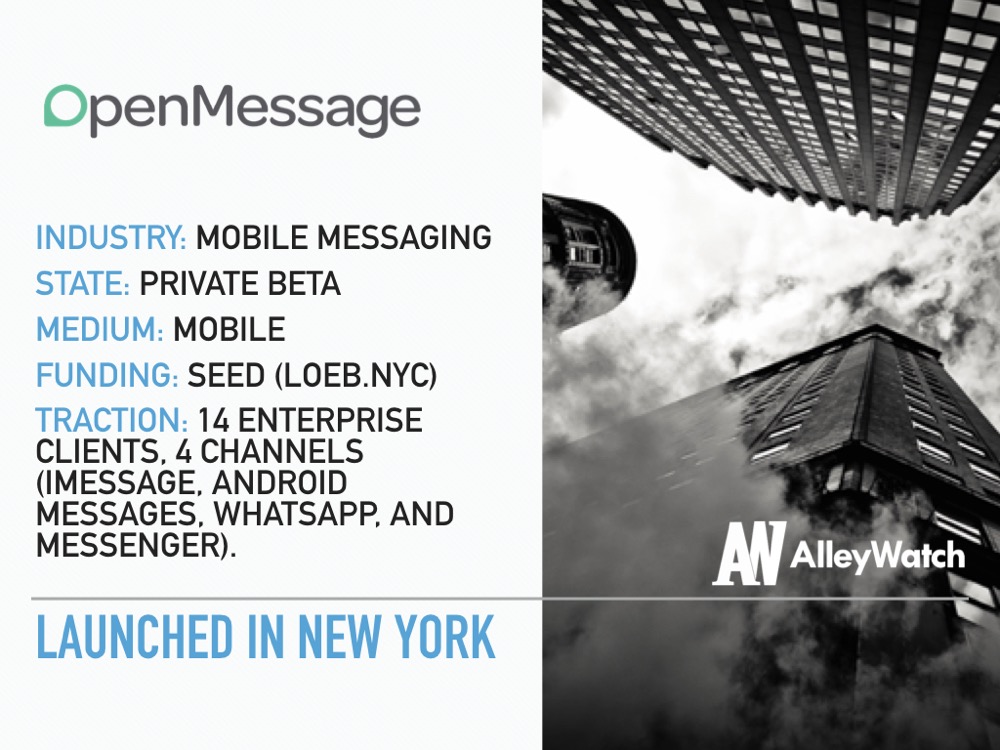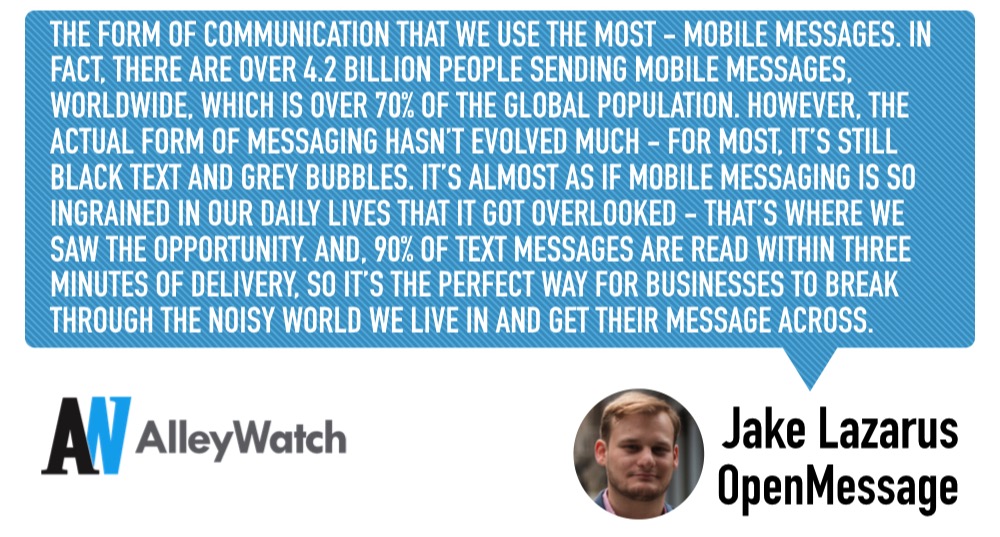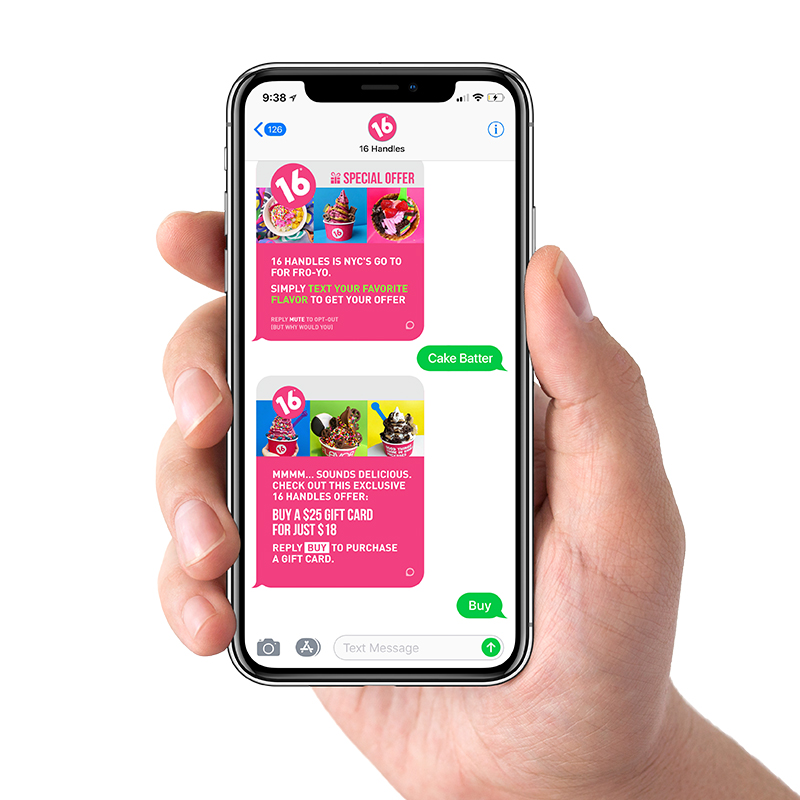Over 4.2 billion people send mobile messages and most of these mobile messages are sent with the traditional black text and grey bubble. While this generic layout may be fine when chatting with friends, it isn’t effective for brands who need to communicate with consumers via mobile message thus OpenMessage created the first Mobile Message Design platform. This platform boosts messaging experiences by giving brands the tools to communicate through personalized, interactive messages filled with color and imagery.
AlleyWatch spoke with founder and CEO Jake Lazarus about how OpenMessage’s creative messaging system is offering a more effective one-step call to-action, the company’s origin, and future plans.
Tell us about the product or service that OpenMessage offers.
OpenMessage is a new solution for brands and publishers to engage with consumers by leveraging an often-overlooked marketing channel – mobile messaging. We offer the world’s first Mobile Message Design platform, which provides organizations the opportunity to communicate with their customers with personalized, interactive messaging experiences that are full of color and imagery.
This approach to mobile messaging helps brands and publishers have more meaningful communication and offers a one-step call-to-action all within a single messaging ecosystem. Our number one priority is to make sure that brands and consumers have a valuable messaging experience. We make sure that every brand’s campaign is beneficial to the consumer or we won’t move forward with it.
How is OpenMessage different?
While other platforms provide generic promotions via black text and grey bubbles, OpenMessage allows businesses to create memorable consumer engagement. By providing a one-to-one conversation that’s visually compelling, personalized, and seamless for anyone to use, we’re helping businesses deepen their relationship with their customers.
Additionally, we’re the only company in the space that’s building brand equity by providing interactive content that drives long-lasting engagement and loyalty. Since our standard of quality is charismatically high, this keeps users engaged and creates a positive messaging experience for all.
What market does OpenMessage target and how big is it?
All businesses can benefit from OpenMessage, but our initial focus has been DTC, retail, travel, hospitality, customer service industry, media, and entertainment. Outside of traditional businesses, we also work with key influencers, artists, and politicians who have used OpenMessage to personally connect with their audience to increase awareness, engagement, and conversion. Most recently, we partnered with Brand Innovators at SXSW and 1800 Tequila to provide their customers exclusive updates, deals, and more.
Both businesses and people come to us when they’re looking to enhance their communication experience and relationship with consumers.
What is the business model?
Our business model is multimodal. It’s a combination of SaaS and utilization based on the volume of messages a business sends. As we roll out our toolset for conversational commerce and inventory monetization in the coming months, we’ll be introducing additional revenue streams that capitalize on those models.
What inspired the start of OpenMessage?
Adam Kostman and I founded OpenMessage because we saw that there was an opportunity for businesses to better leverage the form of communication that we use the most – mobile messages. In fact, there are over 4.2 billion people sending mobile messages, worldwide, which is over 70% of the global population. However, the actual form of messaging hasn’t evolved much – for most, it’s still black text and grey bubbles. It’s almost as if mobile messaging is so ingrained in our daily lives that it got overlooked – that’s where we saw the opportunity.
And, 90% of text messages are read within three minutes of delivery, so it’s the perfect way for businesses to break through the noisy world we live in and get their message across.
As more and more brands start to use messaging as a marketing channel, will consumers be willing to provide access to this medium that has traditionally been reserved for communication with contacts?
Polls have shown that 9 out of 10 people prefer businesses to communicate with text messages over all other channels of communication. Additionally, 100% of the millennials that were polled said that they have joined a messaging list.
Most of today’s consumers want ease, convenience, and accessibility when connecting with any brand. In fact, people are happy to exchange private information like their phone number if it allows them to save money and time. As long as a message provides value to the consumer, the power of messaging will continue to evolve for the brand as well.
What are the milestones that you plan to achieve within six months?
When you have a market as big as business mobile messaging, everything comes down to the product. In the next six months, we are releasing a proprietary conversational commerce solution, an elegant, self-service developer experience, and a suite of messaging audience development products. To make that happen, we’re growing our engineering organization, bringing on great developers from organizations like Stripe and Pager. Our goal is to grow our enterprise client base by 10, the best-in-class in key verticals.
What is the one piece of startup advice that you never got?
Put your product and new capabilities into the wild even if you do not feel they are 100% perfect yet. There is no better way to test a new feature than user feedback.
If you could be put in touch with anyone in the New York community who would it be and why?
I’m not sure if there is any one person, but we are keen on making relationships with the top DTC brands in NYC. We think conversational commerce is the future of DTC businesses and our platform’s text-to-buy capabilities make purchasing or subscriptions with texting a more seamless and convenient way to interact than other mediums.
Why did you launch in New York?
My cofounder Adam and I debated on NYC or San Francisco when we started OpenMessage. Ultimately, we decided with NYC being the major global hub for brands and advertising, that it is the best fit for a startup whose main clients are brands, marketers, and advertisers.
My cofounder Adam and I debated on NYC or San Francisco when we started OpenMessage. Ultimately, we decided with NYC being the major global hub for brands and advertising, that it is the best fit for a startup whose main clients are brands, marketers, and advertisers.
What’s your favorite restaurant in the city?
Prince Street Pizza is right around the corner from my apartment and one of my favorite places for a slice of pizza. It’s a super popular pizza spot, so during peak hours, there is often a line wrapped around the block. But with my proximity to the pizza shop, I can usually find the time to get in during off-hours when the wait is not so bad.






